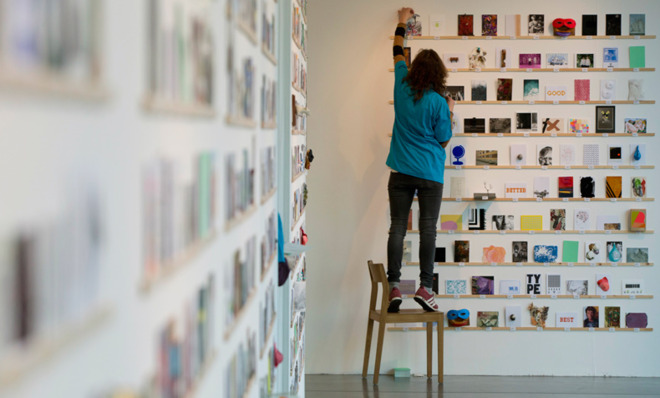Why are there so few prominent women in the art world?
If women in publishing have it bad, then the gender gap in the visual arts is even worse

"Counting," the editors of the London Review of Books declared, "is a feminist weapon."
They were responding to the latest numbers by the advocacy organization VIDA, which conducts an annual count of the number of women published in popular and literary magazines. LBR's response was meant to be as dismissive at it sounds — after all, the magazine had one of the worse male-to-female ratios in the publishing industry. But scoffing aside, counting has become a tool in the feminist arsenal. Every year VIDA, unsurprisingly, reveals a sizable gender gap in the publishing industry — and their methods are being adopted in other fields, as well.
Artists have now joined in by forming their own count. A new project, Gallery Tally, formed by Micol Hebron counts the male/female breakdowns of gallery rosters. The results of their latest count are dismal. If women in publishing have it bad, then the gender gap in the visual arts is even worse. By Hebron's estimation, only 30 percent of the artists represented by commercial galleries are women.
The Week
Escape your echo chamber. Get the facts behind the news, plus analysis from multiple perspectives.

Sign up for The Week's Free Newsletters
From our morning news briefing to a weekly Good News Newsletter, get the best of The Week delivered directly to your inbox.
From our morning news briefing to a weekly Good News Newsletter, get the best of The Week delivered directly to your inbox.
Hebron began counting last year, focusing primarily on galleries in her hometown of Los Angeles. "I became fixated on counting," she told the website Hyperallergic, "I would procrastinate on my studio work by trolling gallery websites and looking up artists, tallying the numbers of male and female artists." But the art world is vast, and when it became clear that she couldn't tackle the project alone, she put out an open call to her fellow artists and Gallery Tally was born. Since then, over 500 artists have participated in the project. Gallery Tally draws on the strengths of their contributors; once the counting is complete, they make a poster for the project's gallery (all of the posters can be viewed here).
Action like Gallery Tally's isn't exactly new in the art world. In 1989, the feminist collective the Guerrilla Girls revealed the staggering gender inequality in their count of the Metropolitan Museum of Art and produced now iconic posters with their count emblazoned across them: "Less than 5 percent of the artists in the modern-art sections are women, but 85 percent of the nudes are female." The Guerrilla Girls bill themselves as the "conscious of the art world," and their continued investment in counting speaks to both the power and problems with a tally as a social justice tool. As of last count in 2012, only 4 percent of artists on display at the Met were women.
Counting can be slow to move storied institutions like the Met, but it throws into relief just how difficult artistic success can be for women. Hebron has said as much about Gallery Tally, "Statistical research, providing objective data that actually quantifies how severe the imbalances are, is a powerful and irrefutable indicator of the conditions in the art world." And counting can place real public pressures on institutions, especially when women represent a core audience. The New York Times' Book Review responded to data showing it infrequently featured female authors when it appointed Pamela Paul as its new editor and made a public commitment to righting the balance.
If counting can slowly turn the behemoths of culture, then it can always reveal those who cling to structural sexism as a defense. When Hebron challenged individual gallery owners — often those with the worst gender ratios — they provided stock defensive answers. Some of the choice responses include: "Women do not have the same drive or passion for their art as men do — they are not willing to die for their passions" and "Women are not as prominent in the art world because they become mothers." If these excuses seem familiar, it's because they are. After the London Review of Books ridiculed counting, they when on to suggest that women's omission from the magazine was their own fault: "[Women] prefer not to write critically about other women" and "…women find it difficult to do their own jobs, look after their children, cook dinner, and write pieces. They just can't get it all done."
A free daily email with the biggest news stories of the day – and the best features from TheWeek.com
Those answers are frustrating because they're deflective. It's difficult to imagine that editors, curators, or gallery owners are consciously excluding women, but both Gallery Talley and VIDA's counts show gender discrimination is as present as ever. There is an important discussion to be had about inequality in the culture industry and the industry should welcome it rather than defensively stick their heads in the sand. It is hard here not to think about the famous line in Virginia Woolf's To the Lighthouse: "Women can't paint, women can't write." Woolf wrote the words to demonstrate just how destructive sexism (institutional and social) can be on the creativity of women. Perhaps, in light of Gallery Tally and VIDA's counts, Woolf's words are worth revisiting. The numbers are indisputable, now it's time understand why the numbers are as they are and try to fix them.
Stassa Edwards is a freelance writer from the Deep South.
-
 Who is paying for Europe’s €90bn EU loan?
Who is paying for Europe’s €90bn EU loan?Today’s Big Question Kyiv secures crucial funding but the EU ‘blinked’ at the chance to strike a bold blow against Russia
-
 Quiz of The Week: 13 – 19 December
Quiz of The Week: 13 – 19 DecemberQuiz Have you been paying attention to The Week’s news?
-
 What’s causing the non-fiction slump?
What’s causing the non-fiction slump?In the Spotlight Readers are turning to crime fiction, romantasy and self-help books as a form of escapism